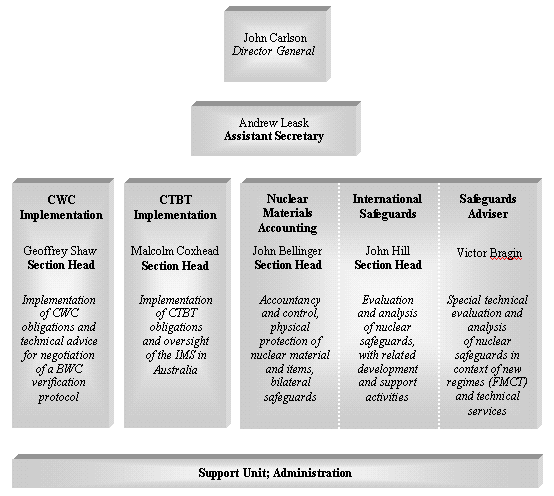


Annual Report 1998-99 |
 |
RESOURCES OVERVIEW: CORPORATE MANAGEMENT
ASNO is required, as part of a Commonwealth Department, and in accordance with sub-section 50(1) of the Audit Act 1901, to submit to the Auditor-General an annual Financial Statement. Details relating to that Financial Statement are contained in the DFAT Annual Report for 1998–99.
ASNO continued to review its administrative and accounting procedures during the reporting period. Revised and new instructions or guidelines issued by DFAT, the Department of Finance and Administration and other regulatory bodies were implemented where applicable.
Further details of ASNO activities relating to financial management and performance, occupational health and safety, industrial democracy and advertising, and market research are contained in the DFAT Annual Report for 1998–99.
Staffing
During 1998–99 ASNO was staffed on a basis similar to a DFAT Division. The Director General holds the statutory office of Director of Safeguards, established under the Nuclear Non-Proliferation (Safeguards) Act 1987. All other staff are employed under the Public Service Act 1922. All staff were employed on a full-time basis. The administrative support unit functioned with a part-time contractor until filled by a permanent officer in May 1999.
The difficulty of recruiting suitably qualified staff led to lengthy vacancy periods, reflected in the underspend on salaries in 1998–99 shown in Table 1.
Table 1. Details of the ASNO Budget and Expenditure for the Reporting Period 1998–99.
| 1998–99 Budget | 1998–99 Actual | |
| Salaries | $891,510 | $778,268 |
| Administrative Costs | $584,075 | $587,906 |
| Total | $1,475,585 | $1,366,174 |
During 1998–99 the following staff changes occurred:
- In February 1999 Andrew Leask was appointed as the Assistant Secretary (this position had been vacant since June 1998).
- In the same month two Executive Officers were appointed, one to the Chemical Weapons Convention Office and the other to the Australian Comprehensive Test-Ban Office.
- In May 1999, a permanent departmental officer was appointed as the Office Manager.
In view of the highly specialised nature of ASNO’s work, it has been an ongoing challenge to ensure the recruitment and retention of suitably skilled staff and the maintenance of their expertise. Given the limited extent of nuclear activities in Australia, and the international orientation of safeguards, practical experience in international safeguards largely has to be obtained overseas. Staff who retire or resign cannot be easily replaced. ASNO has particular needs which are relatively unusual in Public Service terms: these include funding levels sufficient to second staff overseas for extended periods for professional development, and maintenance of an overall level of staff sufficient to provide the flexibility for such secondments and to guarantee continuity of expertise in the face of staff movements.
On the chemical side, ASNO has an extremely small base (1.5 approved positions), making retention of specialist staff particularly difficult. ASNO is very fortunate in currently having three staff members with advanced post-graduate qualifications (PhDs) in chemistry.
An area requiring ongoing attention is the maintenance of ASNO’s funding at a level sufficient to ensure viability. In 1989 the Australian Safeguards Office was subject to external review, which concluded that the then staffing level of 14 was a minimum for the effective performance of its nuclear responsibilities. In the subsequent 10 years there has been a process of continual attrition, due to failure to establish a satisfactory initial base, the cumulative effects of the 'efficiency dividend', and the impact of general Public Service cut-backs. Over the same period there has been a substantial increase in workload, with the increasing quantity of nuclear material covered by Australia’s network of bilateral agreements and the increasing complexity of international issues and developments.
ASNO’s current level of professional staff engaged on nuclear issues is seven—ASNO continues to perform well despite this by virtue of the high degree of expertise and efficiency of current staff members, but key staff members are now at or approaching retirement age. Thus, the present staffing level cannot be considered viable in the medium term and we will seek to have this matter addressed in the coming financial year.
Table 2. Categories of Staff at 30 June 1999.
| Male | Female | Total | |
| SES B2 | 1 | 1 | |
| SES B1 | 1 | 1 | |
| Executive level 2 | 5 | 5 | |
| Executive level 1 | 1 | 1 | |
| APS level 6 | 1 | 1 | |
| APS level 5 | 2 | 2 | |
| APS level 2 | 1 | 1 | |
| Total | 10 | 2 | 12 |
Figure 2. Organisational Chart

Uranium producers pay an amount that has generally corresponded to 40% of ASNO’s annual costs.
The current arrangements were introduced through the Nuclear Safeguards (Producers of Uranium Ore Concentrates) Act 1993, to recover some of the costs of ASNO’s activities which the Government considered to be of benefit to industry. The Act provides for each producer to pay an annual charge, prescribed by regulation, up to a maximum of $500,000.
Following a review as part of the Government’s overhaul of business regulation, in June 1997 it was recommended that the charge on uranium producers be retained, but in a different form—the charge would be a ‘safeguards fee’ per kilogram of production—which was seen as a fairer mechanism than the previous flat fee. The fee would include a component for future costs, that is, the ongoing costs in respect of AONM which could remain in the fuel cycle for a considerable period after the originating mine had ceased production.
In December 1998 the fee was set at 9.5359 cents per kilogram of contained uranium produced during 1997/98, which yielded $468,000 for Consolidated Revenue.